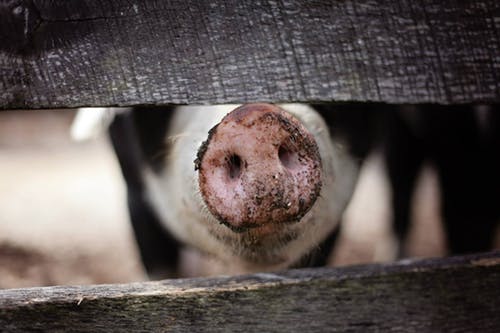By Angela Bates a recent ASU Nutrition Student
Pork is the most consumed meat in the world. According to the Food and Agriculture Organization of the United States, over 36 percent of the world’s meat intake is from pork, while poultry accounts for 35 percent and beef 22 percent. As such an important source of protein for many cultures, pork has had quite the history.
Fossil evidence suggests wild boars have roamed the earth for at about 40 million years. According to the National Pork Board, the Chinese had domesticated pigs by the year 4900 B.C., possibly even earlier, and Europe domesticated by around 1500 B.C. The Romans made big improvements to pig breeding and developed two types of pigs, one for lard and one for meat. There are even ancient Greek baby rattles made in the form of a pig. Pigs became symbols for cultures and “pork” came into the English language during the Norman Conquest of England.

Before 1000 B.C., Jewish religious law banned pork. The belief was that pigs were unclean because they ate waste and possibility of contracting trichinosis, a now rare (about 15 cases per year in the US according to the CDC) infection caused by undercooked or contaminated meat. It is possible that the nomadic cultures seen in those days had trouble keeping pigs, as they required far more water and special food than cattle, camels, or sheep, which could easily move from place to place. The Christian religion also banned the consumption of pork, but the restrictions were dropped by about 50 A.D..
Trade routes throughout Europe and Asia are known for spice trading, but Spanish and Italian salted pork and cured sausages and French pork pâtés were traded across countries and continents. In fact, Marco Polo supposedly spoke of the pork consumption in China in the late 1200s when he returned to Italy and you may see some pork dishes with his name on them in Asian restaurants. Christopher Columbus’ famous 1493 voyage to Cuba included eight pigs, as Queen Isabella insisted he takes them. They were hearty animals who could survive such a treacherous trip, and they did. By the late 1500s, Europeans had begun breeding specific breeds of pigs for different needs, all dark-colored.
The true “father of the American pork industry,” according to history, was Hernando de Soto. He brought a ship with 13 pigs on board to Tampa Bay, Florida in 1593, which had an enormous impact. De Soto died three years after arriving with his pigs, but in that time alone, they had multiplied to an estimated 700 pigs. Some sources say that Native American was so fond of pork, there were attacks to try to get more pigs for their tribes, so some pigs were given to the Native Americans to keep the peace between the cultures. Hernando Cortez brought hogs to New Mexico in 1600 and in 1607, Sir Walter Raleigh brought pigs to the Jamestown colony of Virginia.
During the 1600s, most farmers with pigs owned four to five, which was enough for a family to eat from and to make barreled pork to sell. Barreled pork was hog meat in a salt brine that was stored in wooden barrels. Pork season became an autumn tradition due to the practice of finishing pigs with Native American corn. Wall Street was named after a wall that had to be erected to keep feral pigs out of crops on Manhattan Island. It began as a normal picket fence, but the Dutch built it up to a 12-foot-tall fortress to keep the hogs out.
As the conquest of the western United States began after the revolutionary war, the pioneers took pigs to settle with and for food along the trail. As pig expansion and colonization continued, Americans needed more streamlined pork processing. Cincinnati was the place where pigs were first commercially harvested. Throughout the 1800s, Cincinnati processed more pork than any other place in the United States, earning it the name “Porkopolis.” By the 1840s, about 250,000 pigs were processed every year!
The issue that came with processing so many pigs was getting them to the market and transporting the processed fresh meats. Estimates state that between 40,000 and 70,000 pigs were herded from Ohio to eastern meat markets per year with a total distance of up to 700 miles. Refrigeration, as we know it today, was not developed until the early 1920s, but in 1899, shortly following the Civil War, the Swift Refrigerator Line of railroad cars were introduced. This revolutionized the transport of live pigs and processed products and encouraged the development of a more robust railroad system in American cities. Since most corn was grown in the northern Midwest—the Corn Belt, that’s where hog processing happened—the Hog Belt. Iowa is still the top producer of pork today, selling over twice the amount of the next state, but Arizona has a fantastic pork market as well. With one commercial pork producer up north and a handful of local pork farmers.
Throughout the 1920s to 1940s, the United States became the world’s number one pork producer. When European ally forces were dying of starvation during World War II, the U.S. shipped out over one billion pounds of pork to them, most of which was canned pork, such as Spam During the 1980s and 1990s, disease control, better breeding, increased feed efficiency, and more advancements helped drastically increase pork production. These advancements, along with more efficient and cost-effective transportation and storage, allowed for states not in the Midwest to start producing pork on a large scale. Today, the United States is the largest pork-producing country and we export 26 percent of our pork and pork products to over 100 different countries.
Check out the Fill Your Plate recipe section. If you liked this article, then you will love the Fill Your Plate blog.

